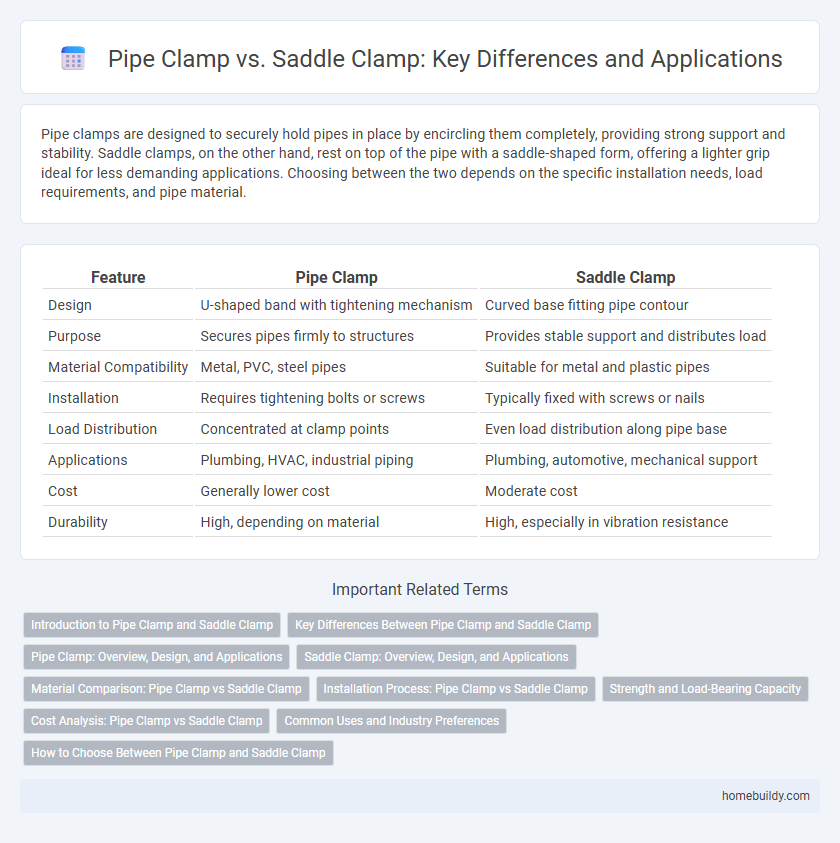Pipe clamps are designed to securely hold pipes in place by encircling them completely, providing strong support and stability. Saddle clamps, on the other hand, rest on top of the pipe with a saddle-shaped form, offering a lighter grip ideal for less demanding applications. Choosing between the two depends on the specific installation needs, load requirements, and pipe material.
Table of Comparison
| Feature | Pipe Clamp | Saddle Clamp |
|---|---|---|
| Design | U-shaped band with tightening mechanism | Curved base fitting pipe contour |
| Purpose | Secures pipes firmly to structures | Provides stable support and distributes load |
| Material Compatibility | Metal, PVC, steel pipes | Suitable for metal and plastic pipes |
| Installation | Requires tightening bolts or screws | Typically fixed with screws or nails |
| Load Distribution | Concentrated at clamp points | Even load distribution along pipe base |
| Applications | Plumbing, HVAC, industrial piping | Plumbing, automotive, mechanical support |
| Cost | Generally lower cost | Moderate cost |
| Durability | High, depending on material | High, especially in vibration resistance |
Introduction to Pipe Clamp and Saddle Clamp
Pipe clamps provide strong, adjustable support for securing pipes in plumbing and construction applications, typically featuring a sturdy metal band that encircles the pipe. Saddle clamps, designed with a U-shaped channel or saddle, offer a more localized grip, ideal for smaller pipes or conduit runs where minimal surface contact is required. Both clamps play crucial roles in pipe management, with pipe clamps emphasizing durability and load-bearing capacity while saddle clamps prioritize compactness and ease of installation.
Key Differences Between Pipe Clamp and Saddle Clamp
Pipe clamps secure pipes by encircling the pipe fully, offering strong support for heavy-duty applications and minimizing movement. Saddle clamps, in contrast, feature a U-shaped design that rests on the pipe's surface, providing easier installation but less stability under high loads. Key differences include load capacity, installation complexity, and the specific use case, with pipe clamps suited for robust structural support and saddle clamps ideal for lighter, surface-mounting tasks.
Pipe Clamp: Overview, Design, and Applications
Pipe clamps provide secure, adjustable support for pipes by encircling them with a metal band tightened by screws or bolts, ensuring stability and minimizing vibrations. Their design features robust materials such as stainless steel or galvanized steel, making them ideal for heavy-duty industrial plumbing, HVAC systems, and construction projects. Widely used for securing both small and large diameter pipelines, pipe clamps accommodate thermal expansion and facilitate maintenance by allowing easy pipe removal and repositioning.
Saddle Clamp: Overview, Design, and Applications
Saddle clamps feature a curved, saddle-shaped design that securely cradles pipes, providing enhanced stability and load distribution compared to traditional pipe clamps. Commonly used in plumbing, HVAC systems, and industrial piping, saddle clamps are ideal for supporting pipes on flat surfaces while minimizing pipe deformation and vibration. Their robust construction and design versatility make them suitable for applications requiring strong mechanical support and corrosion resistance.
Material Comparison: Pipe Clamp vs Saddle Clamp
Pipe clamps are typically made from durable metals such as stainless steel or galvanized steel, offering high corrosion resistance and strength for heavy-duty applications. Saddle clamps often use similar metals but may incorporate rubber or plastic linings to protect pipe surfaces and reduce vibration. The choice between pipe clamp and saddle clamp materials depends on application requirements, with pipe clamps favoring structural integrity and saddle clamps emphasizing pipe surface protection.
Installation Process: Pipe Clamp vs Saddle Clamp
Pipe clamp installation involves securing the clamp around the pipe using bolts or screws, ensuring firm attachment to a surface or support structure. Saddle clamps require positioning the saddle portion beneath the pipe, aligning it with the clamp top, and tightening bolts to create a stable grip. Compared to saddle clamps, pipe clamps generally offer a quicker installation process with fewer components and simplified alignment.
Strength and Load-Bearing Capacity
Pipe clamps generally offer superior strength and load-bearing capacity compared to saddle clamps due to their full 360-degree support around the pipe, which evenly distributes stress and minimizes deformation. Saddle clamps provide partial support and are typically better suited for lighter loads or applications where flexibility is required. For heavy-duty industrial or construction settings, pipe clamps are preferred for maintaining structural integrity under high tension or dynamic loads.
Cost Analysis: Pipe Clamp vs Saddle Clamp
Pipe clamps generally offer a lower initial cost compared to saddle clamps, making them a budget-friendly choice for securing pipes in many industrial and residential applications. Saddle clamps, while typically more expensive upfront due to their robust design and additional materials, provide enhanced durability and support, which may reduce maintenance and replacement expenses over time. Evaluating the total cost of ownership, including installation, longevity, and performance, often reveals pipe clamps as cost-effective for light-duty use, whereas saddle clamps are more economical in heavy-duty or high-stress environments.
Common Uses and Industry Preferences
Pipe clamps are widely used in plumbing, construction, and industrial piping systems to secure pipes firmly and reduce vibration, often preferred for their robust grip and adaptability to various pipe sizes. Saddle clamps, commonly found in electrical and HVAC applications, provide a lighter, simpler attachment ideal for holding pipes or cables against surfaces without full encirclement. Industry preferences lean toward pipe clamps for heavy-duty and high-pressure environments, while saddle clamps suit situations requiring easy installation and minimal surface contact.
How to Choose Between Pipe Clamp and Saddle Clamp
Selecting between a pipe clamp and a saddle clamp depends on the specific application requirements and load capacity. Pipe clamps offer robust support for round pipes, providing stability and resistance to movement, ideal for heavier or thicker pipes. Saddle clamps distribute pressure evenly and are better suited for securing pipes to flat surfaces without causing damage, making them optimal for lighter or more delicate installations.
Pipe clamp vs Saddle clamp Infographic

 homebuildy.com
homebuildy.com